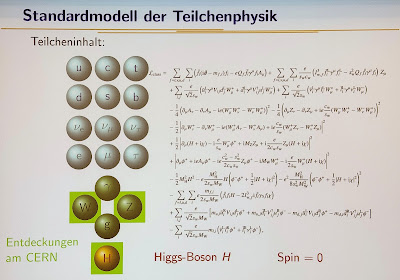Prof. Heidi Rzehak gave the second* lecture at Freiburg University to celebrate CERN's 70th anniversary. She addressed the Open Questions in Particle Physics but first used half of her time to explain the Standard Model of particle physics.
*For the first one,
see here
Here are the building blocks of the Standard Model quarks and leptons. The
intermediate bosons Z and W were discovered at CERN.
Physicists use a mathematical shorthand of the formula, in front of which
the Nobel Prize winners
François Englert
and
Peter Higgs
discuss.
Experimental physicists and theorists work together. A classic example is the discovery of the neutrino. The electrons emitted during β-decay show an energy spectrum, whereas a constant energy was expected.
The famous Wolfgang Pauli postulated the existence of a new particle in a letter to his physics colleagues in 1930:
As the bearer of these lines, whom I ask you to listen to graciously, I will explain to you in more detail, given the "wrong" statistics of the N and Li-6 nuclei, as well as the continuous beta-spectrum, I have fallen back on a desperate way out to save the "alternating theorem" of statistics and the energy theorem. Namely, the possibility that electrically neutral particles, which I will call neutrons, could exist in the nuclei, which have spin 1/2 and follow the exclusion principle, and also differ from light quanta in that they do not travel at the speed of light. The mass of the neutrons would have to be of the same order of magnitude as the electron mass ...
This was the theoretical prediction of the "small neutron," the neutrino, as Enrico Fermi named it in 1932, to distinguish it from the neutron. A neutron actually decays into a proton, an electron, and an (electron) neutrino:
One problem in astrophysics is the necessity of Dark Matter (DM). Its existence reconciles experimental results (upper curve) with theoretical calculations (lower curve).
The observed residual radiation from the Big Bang provides a second argument for the existence of Dark Matter. Only when adding the "correct" amount of DM, i.e., 25%, will an agreement between theory and experimental results be reached.
After merging weak and electromagnetic forces into the electro-weak interaction at 100 GeV in the 1960s, physicists asked themselves whether combining other forces at higher energies was possible.
The question of why there is more matter than antimatter in the universe remains unanswered.
One possible explanation is the violation of CP symmetry, but the experimental results observed so far are insufficient to explain the difference between matter and antimatter.

|
| Click to enlarge |
The Higgs boson H was the missing particle to complete the Standard Theory
and Model. The extremely long Lagrange formula on the right side allows the
calculation of the building blocks presented on the left side.

|
| ©CERN |
Experimental physicists and theorists work together. A classic example is the discovery of the neutrino. The electrons emitted during β-decay show an energy spectrum, whereas a constant energy was expected.
The famous Wolfgang Pauli postulated the existence of a new particle in a letter to his physics colleagues in 1930:
As the bearer of these lines, whom I ask you to listen to graciously, I will explain to you in more detail, given the "wrong" statistics of the N and Li-6 nuclei, as well as the continuous beta-spectrum, I have fallen back on a desperate way out to save the "alternating theorem" of statistics and the energy theorem. Namely, the possibility that electrically neutral particles, which I will call neutrons, could exist in the nuclei, which have spin 1/2 and follow the exclusion principle, and also differ from light quanta in that they do not travel at the speed of light. The mass of the neutrons would have to be of the same order of magnitude as the electron mass ...
This was the theoretical prediction of the "small neutron," the neutrino, as Enrico Fermi named it in 1932, to distinguish it from the neutron. A neutron actually decays into a proton, an electron, and an (electron) neutrino:
n0
→
p+
+
e−
+
ν
e
→
p+
+
e−
+
ν
e
Since CERN's beginnings, neutrino physics has been an important research
branch at the lab.
But now to the open questions of physics.
One problem in astrophysics is the necessity of Dark Matter (DM). Its existence reconciles experimental results (upper curve) with theoretical calculations (lower curve).
The observed residual radiation from the Big Bang provides a second argument for the existence of Dark Matter. Only when adding the "correct" amount of DM, i.e., 25%, will an agreement between theory and experimental results be reached.
After merging weak and electromagnetic forces into the electro-weak interaction at 100 GeV in the 1960s, physicists asked themselves whether combining other forces at higher energies was possible.
If we add the strong interaction, we reach the Grand Unification Theory
(GUT) at 1015 GeV; when we include gravity, it should coincide
with the other forces at 1019 GeV, reaching the point of the
Theory of Everything (TOE). Both energies are far beyond the reach of future
accelerators.
The question of why there is more matter than antimatter in the universe remains unanswered.
One possible explanation is the violation of CP symmetry, but the experimental results observed so far are insufficient to explain the difference between matter and antimatter.
Summary
• Standard Model + General Theory
of Relativity = Theory of almost everything
Standard Model, remarkably well confirmed by the results of the Collider
Experiments
• Standard Model leaves
questions unanswered.
• What is Dark Matter?
• Why is there more matter than antimatter in
the universe?
―> Why do
we exist?
―> Search for physics beyond the Standard Model
• Experimental tests of possible
extensions
―>Important hints for further ideas
―> It remains exciting!
For the question, Why do we exist? See here.
*








No comments:
Post a Comment